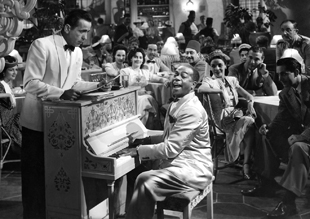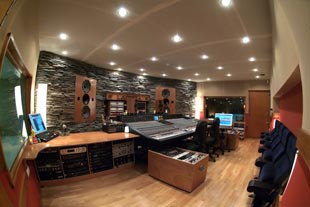![]() ‘Old films were made to work with old media. Today’s film directors have too much confidence in the supposed compatibility between mixing rooms.’ Bold and uncompromising, this is a real challenge facing sound in the movie business.
‘Old films were made to work with old media. Today’s film directors have too much confidence in the supposed compatibility between mixing rooms.’ Bold and uncompromising, this is a real challenge facing sound in the movie business.
It comes from seasoned studio designer and accomplished acoustician Philip Newell, who believes cinema design is locked in the 1970s and is no longer fit for purpose...
As Newell is ready to explain, both situations come down to the same dilemma: ‘It’s a conflict of philosophies,’ he states, ‘to mix in a representative environment or a reference environment.’
It’s not a new conversation as Newell knows, having confronted the same issues in recording studio control rooms a while ago. Surely we can’t be resurrecting problems that we solved 30 years ago, can we? Yes, we can...
Off the record
The root of the problem lies in our approach to the acoustics of commercial cinema rooms. Specifically, the use of the same third-octave analysis and equalisation that once promised to make 1970s studio control rooms sound consistent, if not identical. It was good thinking but naive science. By Newell’s own admission, he may well have made the same mistakes. Critically, the significance of phase and early arrivals were not understood – with the consequent error of addressing a time domain problem (the behaviour of sound in a room) with frequency domain correction (a graphic equaliser). But that was then, and much has been learned since.
In addition to the phase distortion visited on sound by equalisers, other problems arise from using equalisation to ‘correct’ a room – attempting to ‘revive’ frequencies nulled by room cancellation, for example. Once these considerations were understood, a completely new approach to studio acoustics emerged. Attention turned to taming the acoustic behaviour of the room and ensuring the accuracy of the sound source. The third-octave approach was abandoned in favour of short reverberation times and accurate sound sources. Recording studios took a quantum leap forward.
For his part, Newell was instrumental in developing an alternative design strategy to the prevailing Live End-Dead End that was subsequently used in many studios – the ‘non-environment’ room. ‘A lot of people credit me with the non-environment studio design concept but it was Tom Hidley,’ he says. ‘And what Sam Toyashima was doing at the same time wasn’t very different. It took a long time to take hold... now it’s happening all over again with cinema rooms.’
Newell is warming up for a damning talk on commercial cinema room design at the Reproduced Sound conference. He also has the drafts of a current project on the table in front of him – his assignment is to deliver the ‘best possible’ rooms for Russia’s premier film company, NTV Kino. The ‘open brief’ of the commission and his dismissal of prevailing cinema theatre design are no coincidence.
Talking talkies
 History shows how closely in step cinema and sound once were – talkies arrived in 1927 (with The Jazz Singer) following the first moving-coil loudspeaker patent by a mere three years.
History shows how closely in step cinema and sound once were – talkies arrived in 1927 (with The Jazz Singer) following the first moving-coil loudspeaker patent by a mere three years.
By the end of 1929, almost all movies being made were talkies. The technologies that added sound to the silents were used as new weapons in the fight between movie production companies for market share. Controlling their own cinema chains, the likes of MGM, Paramount and 20th Century Fox were at the cutting edge of audio, developing their own systems and optimising sound transfer between studio and cinema.
But while other advances in cinema sound have been dramatic, staying with the X-curve reference and the continued use of third-band EQ correctio have effectively kept cinema acoustics at a standstill.
‘In the early days, film scores used instruments that fitted the reproduction systems of the day and the arrangements didn’t conflict with dialogue,’ Newell points out. ‘The added realism of today’s films – two people talking in a bar with background music playing and a lot of ambient noise – can leave plot point audible in one cinema but not another.
‘It’s understandable if we have misled directors in the past because we didn’t understand. But we can do better now. It’s ironic that cinema demands a higher degree of standardisation than anybody else but relies on an approach that has been rejected by everybody else. Even a live gig in a cinema wouldn’t use third-octave EQ.
 Newell’s proposal is – again – to shift attention from room to source. This, at least, can be made consistent from cinema to cinema, leaving the ear and brain to do the processing. ‘Different sources defy compatibility between rooms,’ he points out. Certainly, hearing is not a passive process and he brain plays a significant part in interpreting sound – how else would an individual voice be as recognisable in a highly reverberant hall as over a 3kHz telephone circuit?
Newell’s proposal is – again – to shift attention from room to source. This, at least, can be made consistent from cinema to cinema, leaving the ear and brain to do the processing. ‘Different sources defy compatibility between rooms,’ he points out. Certainly, hearing is not a passive process and he brain plays a significant part in interpreting sound – how else would an individual voice be as recognisable in a highly reverberant hall as over a 3kHz telephone circuit?
‘The more uniform the source, the better a mix seems to translate to the wide range of commercial cinemas,’ Newell argues. ‘In 2003 we asked Dolby if we could stray outside their approval specification for a dubbing theatre. They agreed on the condition that any negative reaction would mean we had to bring the room back into spec. Instead, word of mouth has brought us requests for more rooms based on this approach..
The studio in question was Loudness in Lisbon. It’s reputation prompted a visit from the Russians in May 2010 – and quickly secured Newell the job of designing the principal mix theatre, Dolby feature room and Foley studio that ate at the heart of a major renovation of NTV-Kino’s historic Gorky Film facility in Moscow.
Founded in 1997 on the foundations of Gorky Film Sudios, NTV-KIno is the leading player in Russia’s film and TV industry, producing TV serials, features and documentaries, as well as animated and full-length feature films. Due for completion next year, this is an industry-defining project that will exploit current technology and work with modern sound levels (115dB) over the 95dB of the 1960s.
Back in the outside world, Newell’s ambitions – if accepted – will not require such drastic action. Instead, they should free professional cinema speaker systems from sometimes crippling EQ and allow them to operate as designed. At worst, some rooms may benefit from a little sound control. It sounds too good to be true...
On top of the sense of his argument, Newell and his team have assembled plenty of documentary evidence to back it up, having begun his investigations in 2006. With some very solid reputations prepared to share his view, the AES has agreed to set up a committee to independently evaluate the initiative. If it wins AES support, the ramifications for the cinema industry could be considerable. What is surprising is the disinterest shown by the SMPTE that drove him to seek another arbiter.
Somehow, that troubles me.






